Below - Photo 1 - SYBA UAUD sound adapter mounted to the WB2EDV circuit board.
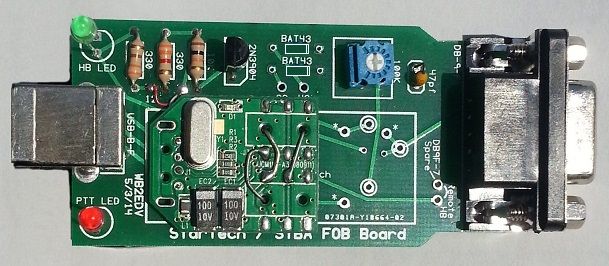
SYBA UAUD USB sound adapter modification
to CM119 based radio interface
For AllStar - Asterisk - app_rpt
By Kevin Custer - W3KKC
|
The device is mostly surface mount, but, depending on your skill level can be modified into an inexpensive USB radio adapter/interface. The instructions provided here will help with the modification of this device to bring out PTT, Main and Aux TX Audio, Receiver audio with variable input control. The construction practice I chose uses WB2EDV's printed circuit board. NOTE: There are no easy provisions for the hardware COS and CTCSS inputs on this particular adapter. This FOB is better used with DSP only! Please read the entire article before starting this conversion - as it's fairly involved! |
Below - Photo 1 - SYBA UAUD sound adapter mounted to the WB2EDV circuit board.

Concept:
The article presented here was the result of modifying a SYBA UAUD USB
sound FOB for use with Chuck Kelsey's printed circuit board. This concept makes
use of a $10 USB FOB, some fairly common components, and a small custom circuit board to
build an inexpensive, but professional looking and working USB radio adapter/interface for AllStar.
Consider a different FOB if you need hardware COS and CTCSS inputs, as the modification of this
board is considerably more difficult. This is because there are no hardware switches for
volume, etc. Adding those inputs is beyond the scope of this article.
Conversion:
Start the conversion by carefully opening the device. Be careful that you don't cut
yourself or run a jeweler's screwdriver through your hand. This process is much like opening
a clam shell - using a pocket knife or small screwdriver with caution. It might be helpful
to grasp one half of the case in a small vice. Also, be careful not to ram the knife or
whatever into the interior of the unit, otherwise damage to the PC board or components can result.
Remove the bias resistor R6 on the CM119 side of the board. This chip resistor, marked R6 - 1.2k ohm [122], normally supplies voltage to the electret condenser microphone. These microphones have an internal audio amplifier which requires voltage to operate. The removal of this resistor does two things: First, it removes the voltage on this lead eliminating the need for another coupling capacitor. Secondly, it raises the input impedance from 1.2k to the value of the input control potentiometer - 100k ohms. See the photo below for a detail of the location of this resistor.
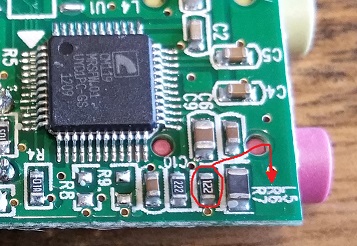
Remove the audio jacks by cutting the straps on each side of the jack and desoldering the ends which remain. You have to be careful as the board is fragile and the circuit traces can lift.
Next, remove the USB connector from the FOB. Snip the 4 conductors close to the USB connector, then desolder the mechanical tabs that remain. Then, clean out the four holes of remaing solder and snipped conductor pins. Resistor clippings, or small diameter solid hook-up wire about 1/2" long, will be placed in each of the 4 holes in a later step. See the photo below for a detail of the removed USB connector and R6.
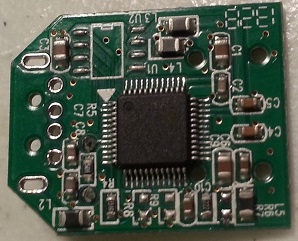
The next step makes connections to pins 12, and 13 on the CM119. Pin 12 drives the HeartBeat (HB) LED, and pin 13 produces the Push To Talk (PTT) signal. Pin 1 is closest to the dimple, and is shown on the board as a white triangle. This step is one of the most difficult, as soldering to pins of the CM119 chip can be challenging without shorting something out. To make these connections, use "Kynar" wire. This is 30 gauge "wire wrap" wire. Since both of these connections are on an end (corner) pin, and because there is enough space to slide the insulated wire underneath the complete row of 12 pins, this process makes it easier to solder. The pins hold the wire in place for soldering. I begin by stripping about 1/16 inch of insulation from a 2 inch piece of wire and sliding it in from the opposite end. Then, with the end of the insulation lined up with the very end of the pin, bend the wire conductor over so it lays beside the pin and carefully solder it. Do this for both connections. I used different colored wires, but that is not necessary if you keep track of your work. See the photo below for a detail of the location of these wires.
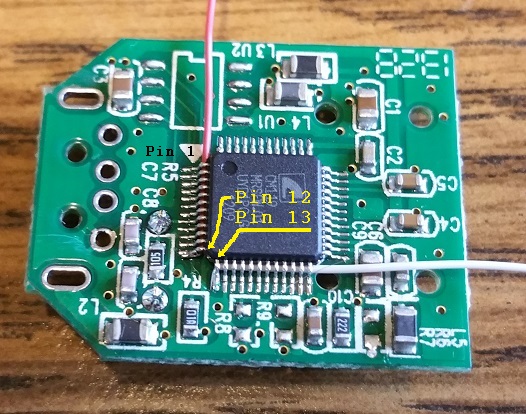
Solder wires into the four holes vacated by the removal of the USB connector. These wires will line up with the four holes in the WB2EDV board. Solder resistor clippings or small diameter solid hook-up wire about 1/2" long in each of the 4 holes Then install the FOB board onto the circuit board making the two boards as close as possible. The CM119 integrated circuit package (on the side that mates with Chuck's board) serves as a spacer keeping the two boards separated, insuring that nothing gets shorted out.
Solder the opposite end of the wire that was connected to the CM119 pin 13 (PTT) to the hole on the circuit board hole marked "13" between the 10k and 330 ohm resistors. Solder the wire coming from CM119 pin 12 to the circuit board hole marked "12".
Solder wires to connect the left and right audio output pads, and
MIC input pad to the circuit board - as shown. These are connected to holes left by removing
the two audio jacks and run to corresponding holes in the larger circuit board. See
the photo below for a detail of the location of the wires.
NOTE: These wires swap sides
because the jacks are reversed on the SYBA UAUD. This is different from the other FOBs
that Chuck's board is compatible with.
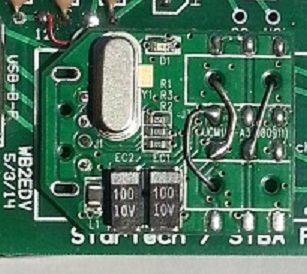
Refer to the parts list and install the remaining components onto the circuit board. The completed interface can be mounted on a blank PCI slot cover or one machined to have a DE-9 hole. The PTT and HB LEDs can be remotely mounted on the slot cover. The completed board can be installed into an optional plastic case. If the plastic case is used, the LED's leads should be left long. The case can be drilled to allow the LEDs to stick through the upper case half for visibility. The LEDs have a flat side and the board has a silkscreen outline which includes a flat side. Insure you orient the polarity of the LEDs correctly!
Completed board installed into optional plastic case. Holes were drilled to allow the LEDs to stick out for visibility.
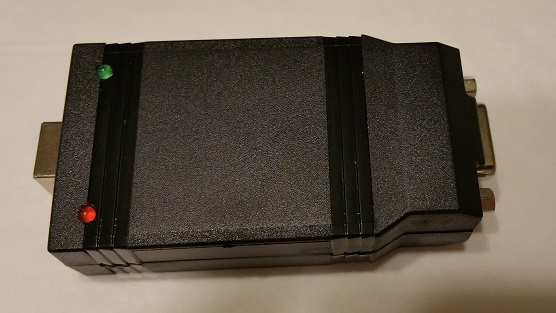
Parts List:
1 - USB-B Jack Mouser 649-61729-1011BLF
1 - DE-9 Female Mouser 152-3409
1 - 100k Trimmer Mouser 652-3362P-1-104LF
1 - 2N3904 Transistor Mouser 2N3904TFR
1 - 47pF Capacitor Mouser 140-100N5-470J-RC
2 - 330 ohm Resistors Mouser 660-CF1/4C331J
1 - 10k Resistor Mouser 291-10K-RC
1 - LED Red Mouser 696-SSL-LX5093ID125
1 - LED Green Mouser 696-SSL-LX5093PGD
1 - Sound FOB SYBA UAUD
1 - WB2EDV circuit board.
1 - Cover PC Slot Expansion cover w/DE-9 cutout (optional)
1 - Plastic Case Mouser 616-73094-510-000 (optional)
NOTE: The BAT43 diodes are not used in this project.
DE-9 Pinout:
1 - Encode sub-audible tone to TX (See Note A)
2 - Audio to TX
3 - Not used (See Note B)
4 - Not used (See Note B)
5 - PTT to TX
6 - Discriminator audio from RX
7 - Spare (could use to remote HeartBeat (HB) LED
8 - Ground
9 - Ground
Notes:
A - Not used if transmitter encoder is utilized.
B - Not used with this particular FOB.
Option - LEDs can be mounted on PC slot cover.
HB LED (green) blinks when the device is recognized by PC.
PTT LED (red) is on when the transmitter is keyed.
I hope you have enjoyed this article.
73,
Kevin Custer - W3KKC
Email Kevin Custer - W3KKC for email support of this modification.
Email Chuck Kelsey - WB2EDV to inquire about FOB circuit boards.
Article by Kevin Custer - W3KKC, all rights reserved.
Circuit board courtesy of Chuck Kelsey - WB2EDV
Specifications may change without notice.
Copyright 2014, Kevin Custer - W3KKC.
Photos property of Kevin Custer - W3KKC.
HTML November 15, 2014, W3KKC - All Rights Reserved!
This web page, this web site, the information presented in and on its pages and in these modifications and conversions is © Copyrighted 1995 and (date of last update) by Kevin Custer W3KKC. All Rights Reserved, including that of paper and web publication elsewhere.